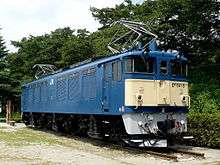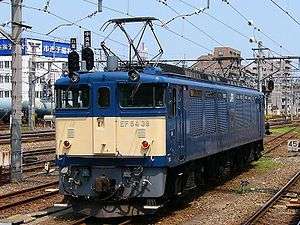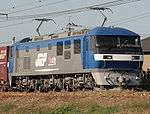JNR Class EF64
|
EF64 38 at Hachioji in July 2004 | |||||||||||||||||||||
| |||||||||||||||||||||
| |||||||||||||||||||||
| |||||||||||||||||||||
| |||||||||||||||||||||
The Class EF64 (EF64形) is a class of 1,500 V DC electric locomotives operating in Japan.
History
The class was designed to replace the ageing EF16 class locomotives used on the steeply-graded Ou and Chuo mainlines in the early 1960s. Two prototype locomotives, EF64 1 and 2, were delivered in 1964, built by Toshiba and Kawasaki Sharyo respectively. The basic body design was based on that of the earlier Class EF62s but with the more usual Japanese Bo-Bo-Bo wheel arrangement. Livery from the start was all-over blue with just the lower cab ends painted cream.
Full production started in 1965, continuing to 1976 with loco EF64 79. Minor variations within the class included the discontinuation of the cab ventilation grilles above the marker lights from EF64 46 onward. Locos EF64 1 to 12 and EF64 29 to 55 were equipped with train-heating generators for passenger use, and are distinguishable by the train heating indicator lights next to the cab doors. The DT120A/DT121A bogies were virtually identical to those used on the Class EF70.
The first batch of locos, consisting of EF64 1 to 12, were assigned to the Ōu Main Line between Fukushima and Yonezawa, where their duties included assisting KiHa 80 Tsubasa DMUs over the steep gradients.
The second batch, from EF64 13 onward, were allocated to the Chuo Main Line for use primarily on freight duties. With the conversion of the Ou Main Line from 1,500 V DC to 20 kV AC electrification in October 1968, the first 12 locos were transferred to the Chuo Main Line.
Nowadays, with the exception of a handful of locos owned by JR East/Central/West for charter and occasional passenger haulage, the subclass is divided evenly between Shiojiri and Aichi depots (JR Freight) at either end of the Chuo Line.
EF64-1000 subclass
The first EF64-1000, EF64 1001, appeared in 1980 for use on the Joetsu Line, replacing ageing Class EF15/16 and EF58 locomotives. This subclass could almost be described as a totally new design. The body was lengthened from 17,900 mm to 18,600, and the bodysides were given an asymmetrical appearance with ventilation grilles at one end and windows at the other. PS22 scissors-type pantographs replaced the PS17 lozenge-type pantographs of the EF64-0s. The bogies were the same DT138A/DT139A type as used on Class EF81 locomotives. A total of 53 EF64-1000s were built by 1982, all by Kawasaki and Toyo Electric. Locos from EF64 1033 onward were built without train-heating generators.
Apart from a handful of locos owned by JR East and based at Takasaki and Nagaoka depots for use on sleeper and charter train haulage, the subclass is largely based at Takasaki for Joetsu Line freight duties. Locos EF64 1046 to 1050, however, are based at Okayama depot for use on Hakubi Line freight duties.
EF64 1030 and 1031, owned by JR East, both have EMU-couplers and jumper sockets, and these locos are frequently used for hauling new rolling stock from the Niitsu factory to Tokyo via the Jōetsu Line, and also for hauling withdrawn rolling stock to Nagano.
 JR Freight EF64 1016 in March 2006
JR Freight EF64 1016 in March 2006 JR East EF64 1052 at the head of an Ueno-bound Akebono sleeping car service in May 2009
JR East EF64 1052 at the head of an Ueno-bound Akebono sleeping car service in May 2009
Life-extension refurbishment
From 1996, the EF64-0s underwent a life-extension refurbishment programme, with EF64 67 the first locomotive treated. Refurbishment was carried out at Omiya and Hiroshima Works, with locos initially released in the JR Freight livery of two-tone blue and light grey. Minor livery variations were implemented during the programme, and locos treated at Hiroshima were distinguished by having mustard-coloured cab gangway doors.
From 2004 onward, the JR Freight livery was simplified by using a single shade of dark blue and light grey.
The first EF64-1000, EF64 1015, also underwent refurbishment in 2003, appearing in the then-standard JR Freight two-tone blue and light grey livery. However, following complaints from staff about the difficulties in visually distinguishing the loco from refurbished EF65s, a new livery was devised and applied to the next loco to be refurbished, EF64 1009, consisting of standard blue with broad white diagonal bands and large red "JRF" bodyside logos. The first Okayama-based EF64-1000, EF64 1047 was refurbished in July 2006 at Hiroshima Works, and this was released in a further simplified livery of all-over blue with white bodyside stripe and light grey lower cab front.
 A pair of refurbished EF64-0s at Tatsuno Station in March 2009
A pair of refurbished EF64-0s at Tatsuno Station in March 2009- EF64 67 in October 2011 in the livery applied to locomotives refurbished at Hiroshima Works
.jpg) Refurbished EF64 1005 at Negishi in May 2010
Refurbished EF64 1005 at Negishi in May 2010 EF64 1049 in revised refurbished livery in July 2013
EF64 1049 in revised refurbished livery in July 2013
Withdrawals
There have been no accident-related withdrawals of EF64s, but the first member of the class was withdrawn in 2003 following the introduction of the JR Freight Class EH200. As of April 2007, 24 EF64-0s had been withdrawn, and a further 9 were in storage. Okayama-based EF64-1021 has also been withdrawn, but the EF64-1000s are expected to remain in service for many years yet following life-extension refurbishment.
Livery variations
- EF64 35 Repainted into white/blue Euroliner livery in August 1990. Although the Euroliner set was withdrawn in April 2005, EF64 35 is allocated to Shizuoka depot (JR Central) and based at Nagoya.
- EF64 37 Painted all-over brown in 2003 to celebrate 100th anniversary of Chuo Main Line between Kofu and Enzan. Allocated to Takasaki depot (JR East), but normally based at Kofu. Used on charter train and engineering train duties.
- EF64 41 Painted all-over brown with gold numbers in May 2006.
- EF64 66 Repainted into white/blue Euroliner livery in August 1985 for use with the 12 series Euroliner Joyful Train set. This was the first EF64 to receive a livery other than standard blue. Operated by JR Central, it was withdrawn in March 2007 and is currently stored at Hamamatsu Works.
- EF64 77 Received a white bodyline stripe and brass depot plates when it hauled the imperial train on the Chūō Mainline in October 1986. Subsequently refurbished and repainted.
- EF64 1001 Painted brown with a white stripe. Allocated to Takasaki depot (JR East), for use on charter train duties, particularly in conjunction with preserved steam locomotive D51 498 and electric locomotive EF55 1.
- EF64 1010 Painted in blue with large yellow "JR" lettering on the body sides, yellow cab ends, and red numberplates.[1]
 JR Central EF64 35 in Euroliner livery in July 2006
JR Central EF64 35 in Euroliner livery in July 2006 JR East EF64 37 in brown livery in November 2009
JR East EF64 37 in brown livery in November 2009 JR East EF64 41 in all-over brown livery with gold numbers in November 2006
JR East EF64 41 in all-over brown livery with gold numbers in November 2006 JR East EF64 1001 in brown with white stripe in April 2007
JR East EF64 1001 in brown with white stripe in April 2007
Preserved examples

- EF64 18: Preserved in a park close to Katsunuma-budōkyō Station on the Chuo Main Line in Koshu, Yamanashi[2]
- EF64 22: Cab end only privately preserved in Tottori Prefecture[2]
- EF64 77: Stored at Inazawa Depot in Aichi Prefecture, restored to imperial train livery with white stripe from November 2012[3]
See also
References
| Wikimedia Commons has media related to JNR EF64. |
- ↑ JR全車輛ハンドブック'92 [JR Rolling Stock Handbook 1992]. Japan: Neko Publishing. 1992. p. 32.
- 1 2 Sasada, Masahiro (September 2012). 国鉄&JR保存車大全 [JNR & JR Preserved Rolling Stock Complete Guide]. Tokyo, Japan: Ikaros Publications Ltd. p. 126. ISBN 978-4863206175.
- ↑ お召仕様のEF64 77がそこに [Imperial train EF64 77 appears]. Japan Railfan Magazine. Vol. 53 no. 622. Japan: Koyusha Co., Ltd. February 2013. p. 155.

